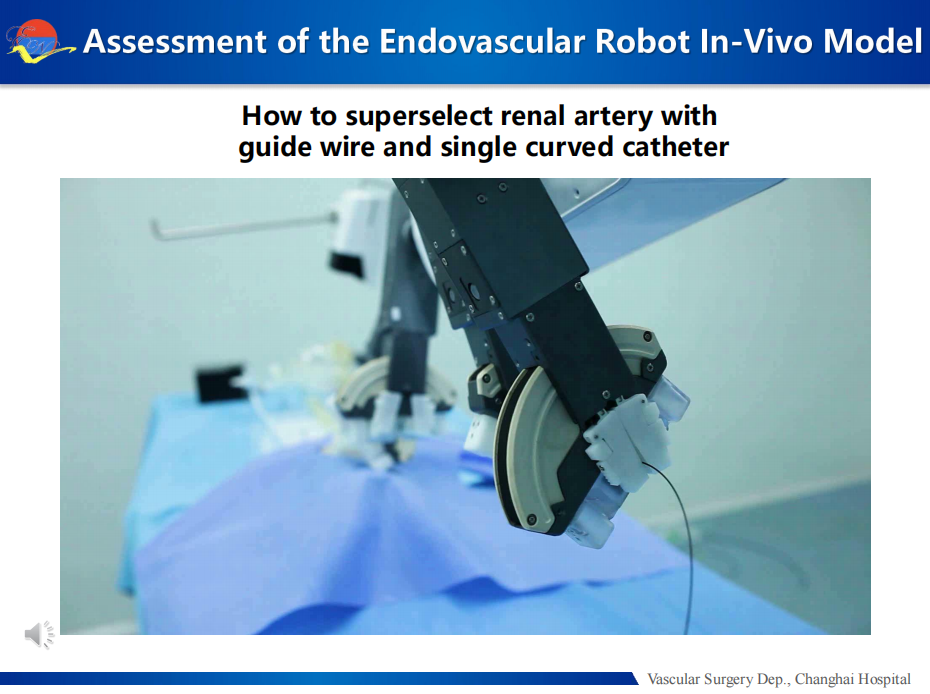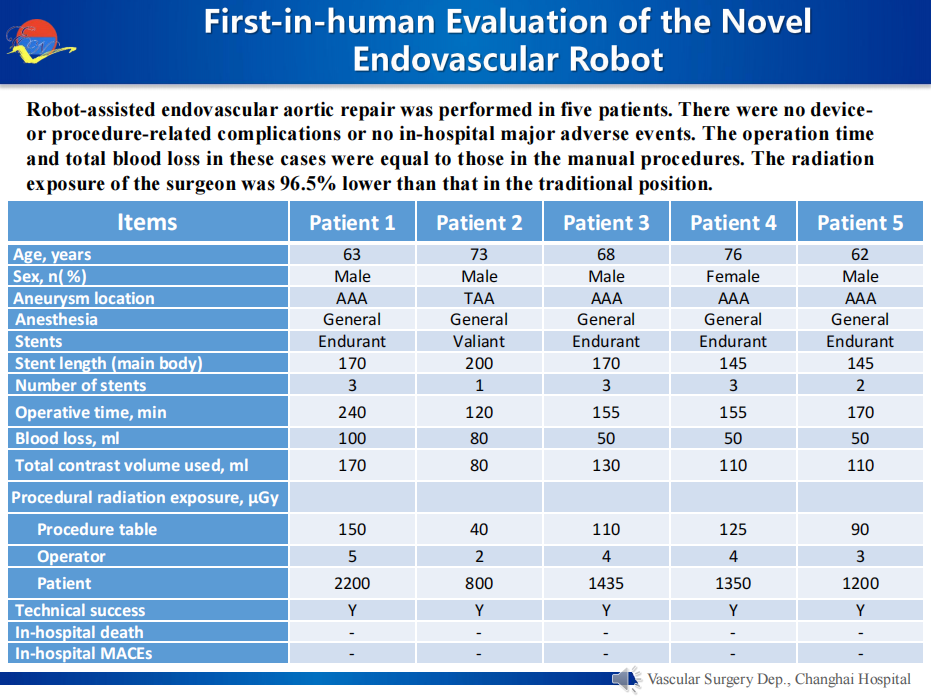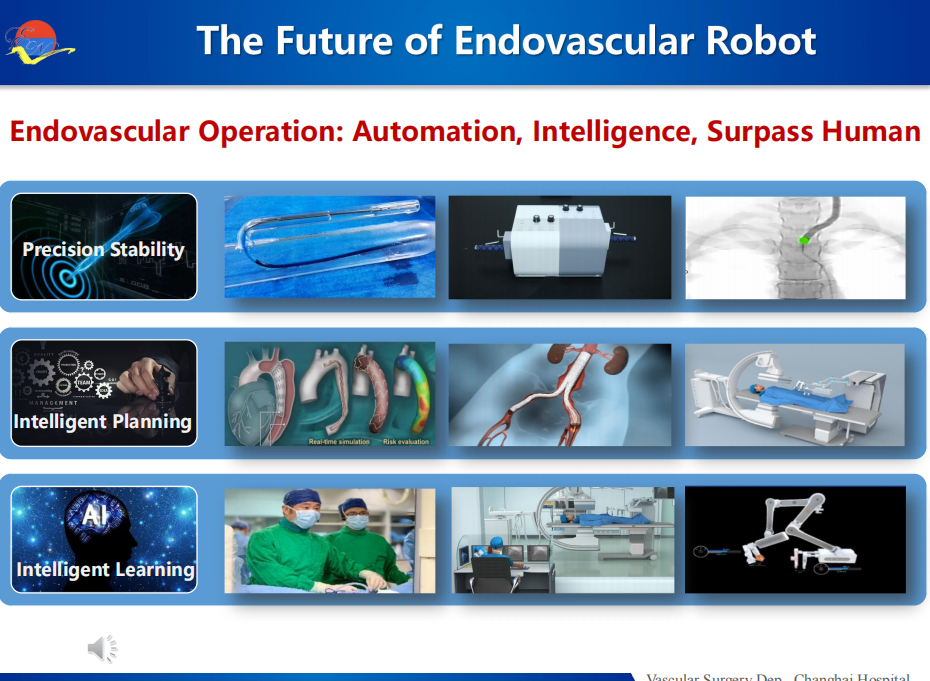
On December 4, 2024, Vasco Knight@ASVS 2024 was held as scheduled at the Athenee, a Luxury Collection Hotel, Bangkok, Thailand. With the theme of "Innovation and Future", the conference brought together top experts in the field of vascular surgery from around the world, focusing on the latest treatment technologies of the aorta and abdominal aorta, the future development trend of China's medical technology, and related practical operations and innovative research and development.
Endovascular surgery (EVS) is an important minimally invasive treatment for aorta, peripheral vascular and coronary artery diseases, but the surgeon is exposed to radiation, complex operating environment, and patient anatomy.
In response to these problems, Professor Lu Qingsheng of the Department of Vascular Surgery of Shanghai Changhai Hospital introduced a new type of intravascular robot-assisted surgical system at the conference, which aims to improve the operation accuracy and reduce the local radiation exposure and operation time of the surgeon. Through the research on the application of robotic surgery for abdominal aortic aneurysm (AAA), thoracic aortic aneurysm (TAA), arterial occlusion and other injuries, the clinical effect of the system was verified, and the advantages, limitations and future development directions of this technology were discussed.

Introduction
Enditarian surgery is a well-established treatment that extensively evaluates aorta, peripheral vascular, and coronary interventions. However, traditional endovascular surgical techniques rely on manual control of the operating tools, which not only increases the radiation exposure to the operator, but also may affect the precision of the procedure, especially when dealing with complex conditions or special anatomical structures. In recent years, the emergence of robotic-assisted surgical systems has provided new possibilities for the precise operation of endovascular surgery. Robotic systems are able to improve operational accuracy, reduce radiation exposure, and optimize the working environment for technicians through precise control and real-time image feedback.
System Design and Technical Principles
01.Management system architecture
The robot-assisted surgical system consists of two arms and four grippers, simulating the good operation of the technician and assistant. Each gripper can be moved independently, adapting to different shapes of catheters, guidewires and holders, and is carried out by the precise control of the robot armThe micron system supports a variety of operating modes, including manual, automatic and semi-automatic modes, and the most suitable operation mode can be selected according to the needs of the technology.

02.Intelligent function
The system integrates intelligent planning, real-time learning, and path optimization algorithms. When performing endovascular operations, the robot is able to automatically and optimally plan the operation path based on the pre-technical 3D image data, and adjust it in real time to adapt to the small changes in vascular anatomy. The system has the ability to learn independently, and can continuously optimize the operation technology according to the surgical data to improve the accuracy and stability.
03.Operation accuracy and stability
The robotic system is capable of precise and ultra-precise manipulation in complex anatomical structures. For example, the system can help operators accurately locate tiny blood vessels such as renal arteries and coronary arteries, and ensure the accurate release of stents, filters and other equipment.

Clinical Applications & Benefits
01.Endovascular repair of abdominal aortic aneurysm (AAA).
Endovascular repair of abdominal aortic aneurysm (AAA) performed by robotic system has significantly improved operational precision and patient safety. In the treatment of 5 AAA patients, the robotic system successfully completed the hypergyration positioning and stent release of the renal artery, abdominal aorta and rabbit artery, and the operation time was comparable to that of traditional surgery, but the radiation exposure of the surgeon was reduced by 96.5%.

02.Endovascular repair of thoracic aortic aneurysm (TAA).
Robotic-assisted surgical systems have demonstrated excellent performance in the treatment of thoracic aortic aneurysms (TAAs). Due to the enlarged curvature of the thoracic aorta, it is easy to create a gap in traditional surgery, but the robotic system can accurately control the release position of the guidewire and stent5 In the operation of TAA patients, the robotic system successfully implemented the precise positioning of the stent, which is prone to surgery-related complications.
03.Treatment of arteriosclerosis of the buttocks
For rabbit arterial occlusion events, robotic-assisted surgical systems are capable of minimally invasive manipulation under complex anatomical conditions. In the treatment of rabbit arterial occlusion, the system ensures effective stent placement through precise guidewire manipulation, and the blood flow of critically ill patients is restored well, and no stent restenosis or other complications are expected to be seen for 12 months.
04.Reduce radiation exposure and the burden on technicians
The application of robotic systems significantly reduces the amount of radiation exposure of the surgeon and reduces radiation injury during surgery. This advantage over traditional surgery is extremely important for vascular surgeons who have been practicing interventional procedures for a long time.
Case Study:
Case 1: Robot-assisted endovascular repair of abdominal aortic aneurysm (RA-EVAR)
· Patient Profile: Male, 63 years old, abdominal aortic aneurysm 6.5 cm in diameter, hypertension and history of coronary heart disease.
· Operation process: The robot system assists in the insertion of superwound guidewires and the operation of stent entry into the home, and accurately locates the heart artery area.
· Results: Within 24 hours, the blood flow was restored well, the renal function was normal, there was no endoleakage in the 6-month follow-up, and the stent was patency.
Case 2: Robot-assisted endovascular thoracic aortic aneurysm repair (RA-TAA)
· Patient Profile: Female, 68 years old, thoracic aortic aneurysm, severe cardiovascular risk.
Procedure: The robotic system was used to perform stent surgery to enter the home, and the thoracic aorta and proximal blood vessels were accurately located.
· Results: The mouse patients recovered well, without complications, and were hemodynamically stable, and the results of the mice at 12 months showed stent patency and no restenosis.

Discussion and outlook
1. Technical advantages
Through intelligent control and convenient operation, the new robot-assisted surgical system can effectively reduce the steps in the treatment of complex vascular lesions and improve the success rate of surgery, especially for high-risk patients and anatomically complex vascular lesions.
2. Future development direction
· Technology integration: Future robotic systems may incorporate artificial intelligence (AI) technology to provide real-time anatomical analysis and surgical optimization.
· Multi-center clinical validation: Conduct a larger, multi-center study to verify the long-term treatment and safety of this technology in various vascular diseases.
· Education and popularization: Conduct training for vascular surgeons and promote the application of robotic-assisted surgical techniques.

conclusion
The novel endovascular robot-assisted surgical system has shown significant clinical advantages in the treatment of vascular diseases such as abdominal aortic aneurysm, thoracic aortic aneurysm and arterial occlusion. With the continuous optimization of technology, it is expected to become an important tool for minimally invasive treatment of vascular surgery in the future, and promote vascular surgery towards a new era of precision and precision.



